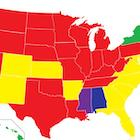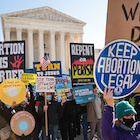Search results
Roe v. Wade, 410 U.S. 113 (1973), was a landmark decision of the U.S. Supreme Court in which the Court ruled that the Constitution of the United States generally protected a right to have an abortion.
Jan 22, 2012 · Roe v. Wade: A person may choose to have an abortion until a fetus becomes viable, based on the right to privacy contained in the Due Process Clause of the Fourteenth Amendment. Viability means the ability to live outside the womb, which usually happens between 24 and 28 weeks after conception.
Videos - Roe v. Wade
Trump touts role in overturning Roe v. Wade, Biden to meet with families of slain officers
CBS News Videos1 month agoFormer President Donald Trump was in Wisconsin and Michigan Wednesday where he hyped up his part in overturning Roe v. Wade and defended his policy of letting states make their own abortion laws. On the Democratic side, President Biden is heading to Charlotte, North Carolina, to meet with the families of the law enforcement officers killed in a shootout this week. CBS News senior White House and political correspondent Ed O'Keefe has more on the campaigns.
Up Next
- 4:08Trump touts role in overturning Roe v. Wade, Biden to meet with families of slain officersCBS News VideosFormer President Donald Trump was in Wisconsin and Michigan Wednesday where he hyped up his part in overturning Roe v. Wade and defended his policy of letting states make their own abortion laws. On the Democratic side, President Biden is heading to Charlotte, North Carolina, to meet with the families of the law enforcement officers killed in a shootout this week. CBS News senior White House and political correspondent Ed O'Keefe has more on the campaigns.1 month ago
- 2:32Donald Trump rallies supporters in crucial battleground statesCBS News VideosFor the first time since his New York criminal trial got underway, former President Donald Trump returned to campaigning on Wednesday, this time in Michigan and Wisconsin, which are two crucial battleground states in the 2024 election. On the campaign trail, he highlighted his role in overturning Roe v. Wade, and emphasized his opinion that abortion should be left to the states. Trump will be in court Thursday as his criminal trial resumes.1 month ago
- 1:53Supreme Court considers when doctors can provide emergency abortions in states with strict bansAssociated Press VideosConservative Supreme Court justices appear skeptical that state abortion bans enacted after the overturning of Roe v. Wade violate federal health care law, though some also are questioning the effects on emergency care for pregnant patients.1 month ago
- 0:49Dueling protests outside U.S. Supreme Court, which was considering emergency abortion issueAssociated Press VideosDueling protests were taking place outside the U.S. Supreme Court in Washington. The court was hearing arguments Wednesday over whether state abortion bans enacted after its sweeping ruling overturning Roe v. Wade can extend to medical emergencies. (AP video: Rick Gentilo, Dan Huff)1 month ago
- 4:17Supreme Court hearing Idaho abortion access caseCBS News VideosTwo years after overturning Roe v. Wade, the Supreme Court is hearing a high-profile abortion case Wednesday involving Idaho's near-total abortion ban. The Biden administration is challenging the Idaho law with a creative legal argument, saying it conflicts with an existing federal law requiring hospitals to provide emergency care for pregnant women, even if it means performing an abortion to save the mother's life. CBS News chief legal correspondent Jan Crawford is at the Supreme Court with more.1 month ago
- 2:24Supreme Court to hear arguments on dispute over Idaho abortion banCBS News VideosLess than two years after the overturn of Roe v. Wade, the Supreme Court is set to hear a high profile case Wednesday on Idaho’s near-total abortion ban that some doctors say is putting pregnant women at risk.1 month ago
- 1:28Supreme Court hears case surrounding Idaho abortion banABC News VideosThis is the first time the Supreme Court is considering the scope of a state’s abortion ban since overturning Roe v. Wade.1 month ago
- 2:19Arizona Republicans uphold 1864 abortion banReuters VideosSTORY: On Wednesday, Democrats in the Arizona state House failed to repeal a controversial ban on abortion that dates back to 1864 after they couldn’t muster Republican support. UPSOT: 1.State Rep. Travis Grantham, Arizona House Of Representatives Speaker Pro Tempore and Republican, Saying (Speaking Over Board Showing Votes): “The motion to overrule my ruling fails.” Meaning the Civil War-era measure is poised to become state law once again. The law imposes a prison sentence of two to five years for anyone found guilty of inducing an abortion except for a doctor who deems it necessary to save the life of the mother. After a series of votes the chamber was deadlocked at 30 to 30 with only one Republican joining the 29 democrats. State representative and Democrat Alma Hernandez said the world is watching: “There are so many people who are watching right now and watching what Arizona is doing. The fact that we will not even entertain a motion to allow those who have been raped or pregnant by incest to be able to have an abortion, is extremely, extremely disappointing.” The old law was revived by a state Supreme Court Ruling on April 9, and unless the legislature intervenes it could take effect in less than two months. Democrats have made clear their intention to put abortion front and center in November’s election, two years after the Supreme Court overturned the landmark 1973 Roe v. Wade decision and ruled that abortion was not constitutionally protected. Opposing abortion is seen as sacrosanct to many Republican voters, including Republican State representative and Speaker Ben Toma: “I understand that we have deeply held beliefs. And I would ask everyone in this chamber to respect the fact that some of us who believe that abortion is, in fact, the murder of children.” However, repealing the 1864 law would still leave in place a law passed by state Republicans in 2022 which bans abortion after 15 weeks of pregnancy. Arizona Democrats are also attempting to add ballot measures before voters in November that would restore their abortion rights.2 months ago
- 2:39Arizona abortion law faces criticismCBS News VideosBoth Democrats and Republicans are criticizing a Civil War-era abortion ban that's set to take effect after Arizona's Supreme Court ruled the statute could be enforced. President Biden has vowed to restore Roe v. Wade if reelected, while former President Trump said the Arizona law goes too far. Nancy Cordes has the latest.2 months ago
- 3:38Trump says Arizona abortion ban went too farABC News VideosFormer President Donald Trump appointed three of the justices who voted in 2022 to overrule Roe v. Wade's national guarantees to abortion access.2 months ago
Mar 27, 2018 · Roe v. Wade was a landmark legal decision issued on January 22, 1973, in which the U.S. Supreme Court struck down a Texas statute banning abortion, effectively legalizing the procedure across...
2 days ago · Roe v. Wade, legal case in which the U.S. Supreme Court on January 22, 1973, ruled (7–2) that unduly restrictive state regulation of abortion is unconstitutional. The Court held that a set of Texas statutes criminalizing abortion in most instances violated a constitutional right to privacy.
The case involved a Texas statute that prohibited abortion except when necessary to save the life of the pregnant woman. The Supreme Court, in a decision written by Justice Blackmun, recognized a privacy interest in abortions.
At a time when Texas law restricted abortions except to save the life of the mother, Jane Roe (a single, pregnant woman) sued Henry Wade, the local district attorney tasked with enforcing the abortion statute. She argued that the Texas law was unconstitutional.
In 1970, Jane Roe (a fictional name used in court documents to protect the plaintiff’s identity) filed a lawsuit against Henry Wade, the district attorney of Dallas County, Texas, where she resided, challenging a Texas law making abortion illegal except by a doctor’s orders to save a woman’s life.
In deciding for Roe, the U.S. Supreme Court invalidated all state laws that prohibited first-trimester abortions. Roe v. Wade stood as a precedent for nearly 50 years, but in 2022, the decision was overruled in Dobbs v. Jackson Women’s Health Organization.
Mar 17, 2023 · One of the Supreme Court's most famous cases, Roe v. Wade changed the way states can regulate abortion services by establishing new privacy rights for women. Learn more about this influential case on FindLaw's Supreme Court Insights.
Roe v. Wade is the Supreme Court case that held that the Constitution protected the right to an abortion prior to the viability of the fetus. In 2022, the Supreme Court reversed Roe and Planned Parenthood of Southeastern Pennsylvania v. Casey (see entries on Dobbs v.























